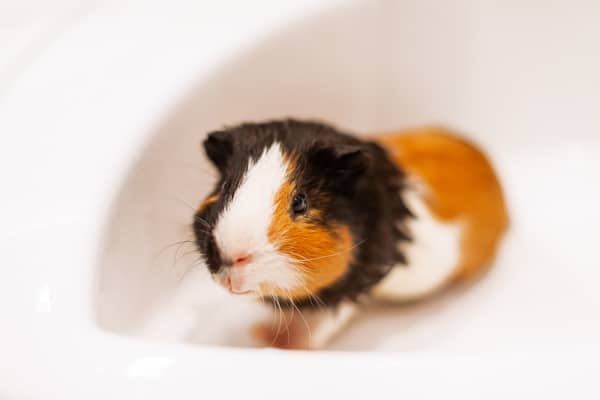Do Guinea Pigs Come From a Specific Region? Explained
Guinea pigs are often thought to have originated from a specific region in South America. However, the reality might surprise you. While their roots can be traced back to a particular geographic area, the journey of these beloved pets is more intricate than meets the eye.
Understanding the unique history and evolution of guinea pigs sheds light on their fascinating connection to a specific region and how they came to be cherished companions worldwide.
Geographic Distribution of Guinea Pigs
Guinea pigs, originating from the Andean region of South America, are primarily found in countries such as Peru, Bolivia, and Ecuador, where they thrive in habitats abundant with vegetation. These adorable rodents have a significant historical significance in the Andean region, where they were domesticated as early as 5,000 BC. The domestication of guinea pigs provided a vital food source for the indigenous people of South America and played a crucial role in their daily lives.
Spanish traders introduced guinea pigs to Europe, where they quickly became popular as domesticated animals due to their gentle nature and ease of care. In addition to being valued as pets, guinea pigs were also used for scientific research and as subjects in religious rituals in South America. Their adaptability and docile temperament have led to their widespread popularity worldwide, making them beloved companions for many people across the globe.
Origins of Domestic Guinea Pigs
Having established the geographical distribution of guinea pigs primarily in countries such as Peru, Bolivia, and Ecuador, the origins of domestic guinea pigs can be traced back to the Andean region of South America around 5,000 BC. Domestic guinea pigs were initially derived from wild species like C. aperea, C. fulgida, and C. tschudii in the Andean region, with ancient DNA analysis pinpointing their origin to the Central Andean region. The domestication of guinea pigs was a significant development, with these small animals being transported to regions like the Caribbean, Europe, and the Southeastern United States for domestication and cultural purposes.
The process of guinea pig domestication likely occurred independently in Peru and Colombia, contributing to their widespread distribution and adaptation in various regions. This historical domestication event not only transformed the relationship between humans and guinea pigs but also played a crucial role in the cultural practices and traditions of the Andean people. The origins of domestic guinea pigs in the Andean region underscore the long-standing connection between these animals and the indigenous communities of South America.
Evolutionary History of Guinea Pigs

The evolutionary trajectory of guinea pigs is intricately intertwined with the cultural and environmental landscapes of the Andean region in South America. Here are some key points regarding the evolutionary history of guinea pigs:
- Andean Origins: Guinea pigs likely originated in modern-day Peru within the Andean region, a location that played a pivotal role in their early evolution.
- Central Andean Influence: Ancient DNA analysis has pinpointed the Central Andean region as the cradle of guinea pig domestication, shedding light on their genetic roots.
- Independent Domestication: The domestication of guinea pigs is believed to have occurred independently in Peru and Colombia, showcasing the diverse paths that led to the taming of these animals.
- Cultural Impact: Cultural practices in Peru and Colombia likely played a significant role in shaping the evolutionary history of guinea pigs, highlighting the deep connection between human societies and these beloved creatures.
Understanding the evolutionary history of guinea pigs provides insights into their origins and the cultural practices that influenced their domestication in the Andean region of South America.
Guinea Pig Domestication Process
Exploring the process of guinea pig domestication unveils a fascinating journey of independent evolution in Peru and Colombia, intricately shaped by cultural practices and genetic roots in the Andean region. The origins of guinea pigs can be traced back to the Central Andean region of South America, specifically in Peru and Colombia. Ancient DNA analysis has provided insights into the domestication process of these small mammals, highlighting the significant role played by the Andean region in their development. Cultural practices in Peru and Colombia further enhanced the domestication of guinea pigs, showcasing the deep connection between humans and these animals in the region.
| Aspects | Details | Importance |
|---|---|---|
| Origins | Central Andean region of South America | Traced through DNA |
| Domestication | Independently in Peru and Colombia | Shaped by culture |
| Cultural Practices | Role in domestication process | Enhancing relationship |
Global Spread of Guinea Pigs

As researchers delve into the global spread of guinea pigs, their journey from the Andean region of South America to various corners of the world becomes increasingly intricate and fascinating. The domestication of guinea pigs dates back to around 5,000 BC in the Andean region, primarily in present-day Peru and Colombia. From these origins, guinea pigs were transported to different parts of the world, including the Caribbean, Europe, and the Southeastern United States, where they played various roles.
The analysis of ancient DNA has provided insights into the roots of guinea pigs, pinpointing the Central Andean region of South America as a significant center for their domestication. This genetic evidence suggests that guinea pig domestication likely occurred independently in both Peru and Colombia, contributing to their global spread. Over time, guinea pigs have transitioned from being primarily food sources to becoming cherished pets, showcasing their versatility and the historical evolution of their relationship with humans.
Conclusion
In conclusion, guinea pigs have a specific geographic origin in the Andean region of South America. They were first domesticated around 5000 BC. Their ancestors, the wild cavies, lived in small herds before the domestication process led to the development of various domestic guinea pig varieties through selective breeding efforts.
Understanding the evolutionary history and domestication process of guinea pigs sheds light on their unique origins and global spread as beloved pets.







